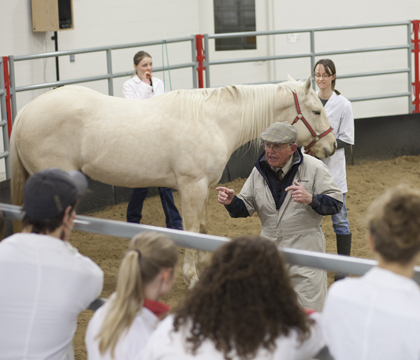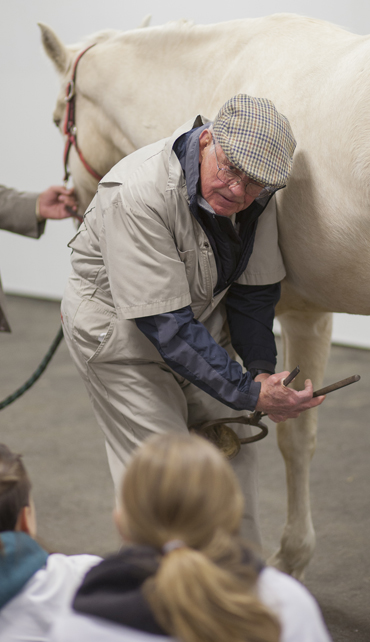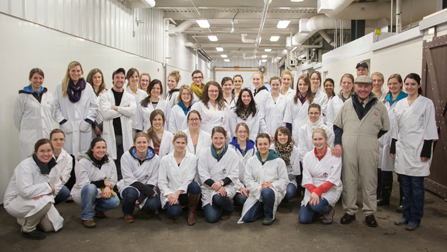
Lameness expert shares tips with students
Whether he's sharing tips on using hoof testers or offering advice on succeeding as a veterinarian, Dr. Marvin Beeman's passion for equine medicine is evident in everything he says and does.
By Hayley Kosolofski
Beeman, one of the founders of the well known Littleton Equine Medical Center in Littleton, Colo., has had a very long and illustrious career in equine medicine. The octogenarian is especially renowned for his understanding of equine lameness.
His short visit to the WCVM in early March was the ideal chance for members of the college's Student Chapter of the American Association of Equine Practitioners — including me — to learn from his wealth of knowledge on lameness and conformation and to hear more about his experiences in building a successful equine practice.
Beeman's visit to the WCVM began with an afternoon lecture on equine conformation and the relationship of a horse's form to function. While we are taught equine anatomy and physiology in school, Beeman's seminar brought those subjects together to understand the dynamics of the horse's movement.

As Beeman explained, it's important for veterinarians to understand conformation as it can explain a lameness or help to predict how a horse will deal with the physical stresses of performance.
Beeman's goal was to teach us "to learn to see what you're looking at." In many situations, the answer to lameness is right in front of us — but we need a complete understanding of conformation to differentiate normal from abnormal.
Beeman spoke of three components of evaluating conformation: standard of excellence, dynamics of locomotion and soundness.
To know the definition of bad conformation, veterinarians must have a picture of good conformation in their minds for comparison — a standard of excellence. While no horse has perfect conformation, near-perfect conformation allows a horse to deal with the added stress on the body from performance.
Understanding the dynamics of locomotion — or how a horse moves — is important to identify where the forces of performance act on the horse's body. This helps us to understand the pathology or cause of lameness.
Finally, soundness refers to a horse that is free of disease and injury and able to perform the task at hand. Unsoundness usually arises from the musculoskeletal system and is related to stress, strain and concussion.
Conformation defects distract from the standard of excellence, limit the dynamics of locomotion and predispose the horse to unsoundness. More often than not, conformation defects occur in a combination.
Beeman then described the systematic approach to evaluating lameness in a horse. A systematic approach enables veterinarians to be as objective as possible and to ensure that no part of the horse is missed. He referred to the same five categories that are described by the Alberta Horse Improvement Program:
Beeman concluded his lecture by asking students to evaluate cases of equine lameness and put into practice the principles we had just discussed. We evaluated the horses' conformation and discussed how conformation abnormalities relate to each horse's lameness issue. It was the ideal chance to bring together the elements of anatomy, physiology and pathology that we have learned so far in school.
The seminar also included a laboratory where Beeman led us through a full equine lameness examination — emphasizing the need for a thorough examination and a complete history.

Once again, he underlined the importance of a systematic approach: we need to ensure that any test we perform on a horse — such as hoof tests or flexion tests — is applied consistently. This helps us to compare the lame foot to the normal foot or the response of one horse in comparison to another.
Another one of Beeman's key messages: make the lameness examination as objective as possible. He also advised that veterinarians do all of the tests themselves. As he explained, only the person who performs the test understands what pressure or technique was used — and that can be critical information to interpret the horse's response.
Beeman shared practical tips for using hoof testers, performing nerve blocks and leading or longeing a horse during a lameness examination. Throughout the day, he also offered nuggets of invaluable advice on how to succeed in equine medicine.
Beeman's enthusiasm for his work and teaching made the day one of those learning experiences I will always remember.
Hayley Kosolofski is a third-year veterinary student from Sherwood Park, Alta., who is the undergraduate student representative for the WCVM's Equine Health Research Fund.
His short visit to the WCVM in early March was the ideal chance for members of the college's Student Chapter of the American Association of Equine Practitioners — including me — to learn from his wealth of knowledge on lameness and conformation and to hear more about his experiences in building a successful equine practice.
Beeman's visit to the WCVM began with an afternoon lecture on equine conformation and the relationship of a horse's form to function. While we are taught equine anatomy and physiology in school, Beeman's seminar brought those subjects together to understand the dynamics of the horse's movement.

As Beeman explained, it's important for veterinarians to understand conformation as it can explain a lameness or help to predict how a horse will deal with the physical stresses of performance.
Beeman's goal was to teach us "to learn to see what you're looking at." In many situations, the answer to lameness is right in front of us — but we need a complete understanding of conformation to differentiate normal from abnormal.
Beeman spoke of three components of evaluating conformation: standard of excellence, dynamics of locomotion and soundness.
To know the definition of bad conformation, veterinarians must have a picture of good conformation in their minds for comparison — a standard of excellence. While no horse has perfect conformation, near-perfect conformation allows a horse to deal with the added stress on the body from performance.
Understanding the dynamics of locomotion — or how a horse moves — is important to identify where the forces of performance act on the horse's body. This helps us to understand the pathology or cause of lameness.
Finally, soundness refers to a horse that is free of disease and injury and able to perform the task at hand. Unsoundness usually arises from the musculoskeletal system and is related to stress, strain and concussion.
Conformation defects distract from the standard of excellence, limit the dynamics of locomotion and predispose the horse to unsoundness. More often than not, conformation defects occur in a combination.
Beeman then described the systematic approach to evaluating lameness in a horse. A systematic approach enables veterinarians to be as objective as possible and to ensure that no part of the horse is missed. He referred to the same five categories that are described by the Alberta Horse Improvement Program:
- head, neck, body and balance
- front limb
- rear limb
- type
- way of going
Beeman concluded his lecture by asking students to evaluate cases of equine lameness and put into practice the principles we had just discussed. We evaluated the horses' conformation and discussed how conformation abnormalities relate to each horse's lameness issue. It was the ideal chance to bring together the elements of anatomy, physiology and pathology that we have learned so far in school.
The seminar also included a laboratory where Beeman led us through a full equine lameness examination — emphasizing the need for a thorough examination and a complete history.

Once again, he underlined the importance of a systematic approach: we need to ensure that any test we perform on a horse — such as hoof tests or flexion tests — is applied consistently. This helps us to compare the lame foot to the normal foot or the response of one horse in comparison to another.
Another one of Beeman's key messages: make the lameness examination as objective as possible. He also advised that veterinarians do all of the tests themselves. As he explained, only the person who performs the test understands what pressure or technique was used — and that can be critical information to interpret the horse's response.
Beeman shared practical tips for using hoof testers, performing nerve blocks and leading or longeing a horse during a lameness examination. Throughout the day, he also offered nuggets of invaluable advice on how to succeed in equine medicine.
Beeman's enthusiasm for his work and teaching made the day one of those learning experiences I will always remember.
Hayley Kosolofski is a third-year veterinary student from Sherwood Park, Alta., who is the undergraduate student representative for the WCVM's Equine Health Research Fund.
